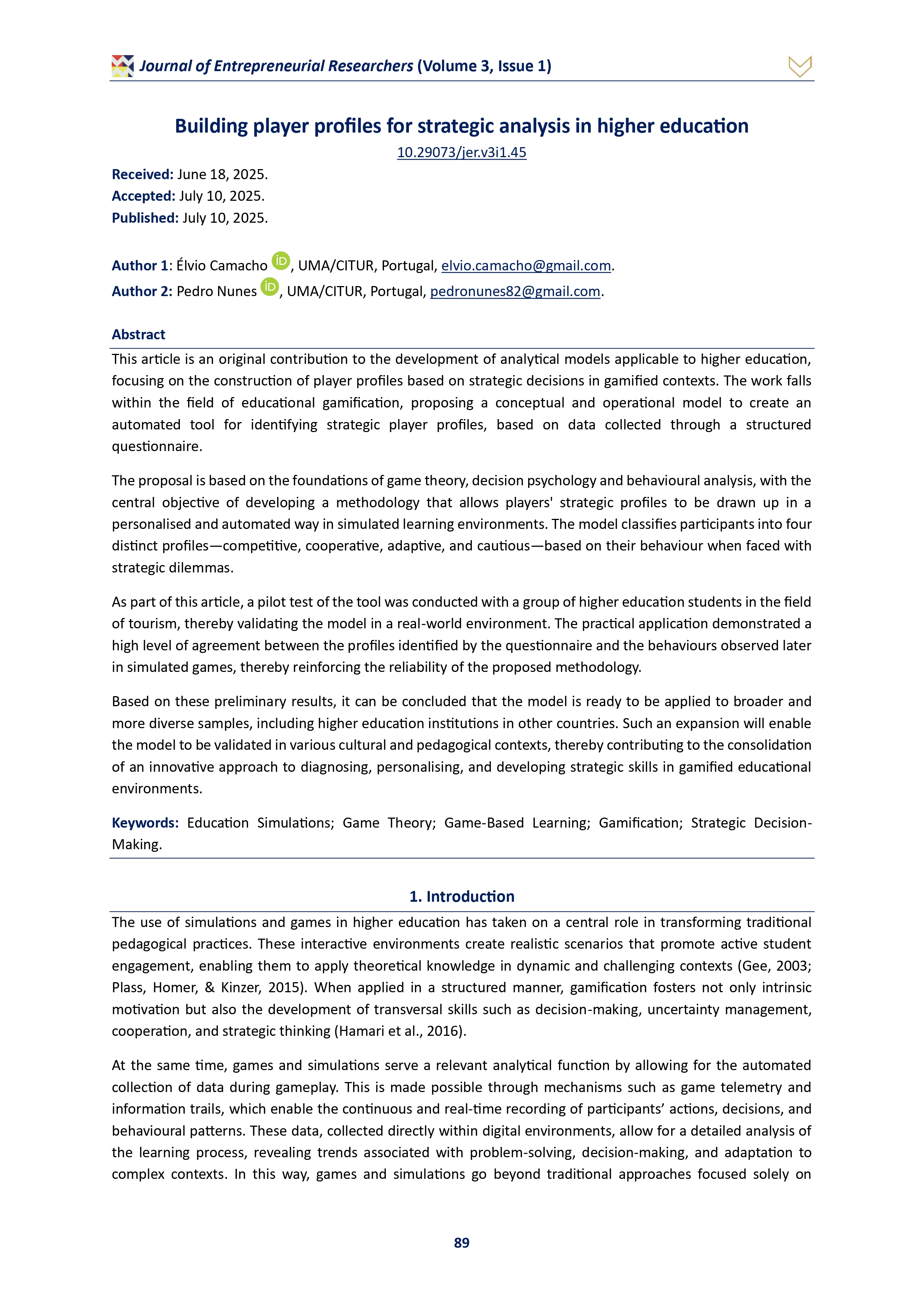Building player profiles for strategic analysis in higher education
DOI:
https://doi.org/10.29073/jer.v3i1.45Keywords:
Education Simulations, Game Theory, Game-Based Learning, Gamification, Strategic Decision-MakingAbstract
This article is an original contribution to the development of analytical models applicable to higher education, focusing on the construction of player profiles based on strategic decisions in gamified contexts. The work falls within the field of educational gamification, proposing a conceptual and operational model to create an automated tool for identifying strategic player profiles, based on data collected through a structured questionnaire.
The proposal is based on the foundations of game theory, decision psychology and behavioural analysis, with the central objective of developing a methodology that allows players' strategic profiles to be drawn up in a personalised and automated way in simulated learning environments. The model classifies participants into four distinct profiles—competitive, cooperative, adaptive, and cautious—based on their behaviour when faced with strategic dilemmas.
As part of this article, a pilot test of the tool was conducted with a group of higher education students in the field of tourism, thereby validating the model in a real-world environment. The practical application demonstrated a high level of agreement between the profiles identified by the questionnaire and the behaviours observed later in simulated games, thereby reinforcing the reliability of the proposed methodology.
Based on these preliminary results, it can be concluded that the model is ready to be applied to broader and more diverse samples, including higher education institutions in other countries. Such an expansion will enable the model to be validated in various cultural and pedagogical contexts, thereby contributing to the consolidation of an innovative approach to diagnosing, personalising, and developing strategic skills in gamified educational environments.
Downloads
References
Aydin, M., Karal, H., & Nabiyev, V. (2022). Adaptive educational games: A systematic review. Education and Information Technologies, 27, 2365–2385. https://doi.org/10.1007/s10639-022-11462-1
Bartle, R. (1996). Hearts, clubs, diamonds, spades: Players who suit MUDs. Journal of MUD Research, 1(1), Article 19.
Bicalho, L. F., Baffa, A., & Feijó, B. (2019). A game analytics model to identify player profiles in single-player games. In 2019, 18th Brazilian Symposium on Computer Games and Digital Entertainment (SBGames) (pp. 11–20). IEEE. https://doi.org/10.1109/SBGames.2019.00013
Gee, J. P. (2003). What video games have to teach us about learning and literacy? Palgrave Macmillan.
Hamari, J., Koivisto, J., & Sarsa, H. (2016). Does gamification work? A literature review of empirical studies on gamification. In Proceedings of the 49th Hawaii International Conference on System Sciences (HICSS) (pp. 3025–3034). IEEE. https://doi.org/10.1109/HICSS.2014.377
Irrera, D. (2021). Simulating conflict resolution dynamics and fostering negotiation skills. OASIS, 33, 13–28. https://doi.org/10.18601/16577558.n33.03
Kim, S. S., & Prideaux, B. (2006). An investigation of the relationship between South Korean domestic public opinion and support for Mt. Gumgang tourism. Tourism Management, 27(3), 448–459. https://doi.org/10.1016/j.tourman.2004.11.006
Loh, C. S., & Li, I.-H. (2016). Using players’ gameplay action-decision profiles to prescribe training: Reducing training costs with serious games analytics. In Proceedings of the 3rd IEEE International Conference on Data Science and Advanced Analytics (DSAA 2016): Special Sessions on Game Data Science (GDS) (pp. 650–659). IEEE. https://doi.org/10.1109/DSAA.2016.87
Loh, C. S., Sheng, Y., & Ifenthaler, D. (2015). Serious games analytics: Theoretical framework. In C. S. Loh, Y. Sheng, & D. Ifenthaler (Eds.), Serious games analytics (pp. 3–29). Springer. https://doi.org/10.1007/978-3-319-05834-4_1
Mizrahi, D., Laufer, I., & Zuckerman, I. (2020). Individual strategic profiles in tacit coordination games. Journal of Experimental & Theoretical Artificial Intelligence, 33(1), 63–78. https://doi.org/10.1080/0952813X.2020.1721572
Mizrahi, D., Laufer, I., & Zuckerman, I. (2024). Neurophysiological insights into sequential decision-making: Exploring the secretary problem through ERPs and TBR dynamics. BMC Psychology, 12, Article 245. https://doi.org/10.1186/s40359-024-01750-5
Plass, J. L., Homer, B. D., & Kinzer, C. K. (2015). Foundations of game-based learning. Educational Psychologist, 50(4), 258–283. https://doi.org/10.1080/00461520.2015.1122533
Slater, S., Thompson, A. C., & Lin, K. (2022). Behavioural profiles and learning outcomes in physics simulations. In G. Conole et al. (Eds.), Lecture Notes in Computer Science: Vol. 13485 (pp. 653–662). Springer. https://doi.org/10.1007/978-3-031-11647-6_62
Yin, H. (2020). Effectiveness of a negotiation simulation game in IB learning. Journal of Teaching in International Business, 31(1), 28–50. https://doi.org/10.1080/08975930.2020.1735315
Zare, R., Maleki, S., & Gharehchopogh, F. S. (2022). Predictive modelling of opponent strategies in RoboCup simulation. arXiv preprint. https://doi.org/10.48550/arXiv.2205.10953

Downloads
Published
How to Cite
Issue
Section
License
Copyright (c) 2025 Journal of Entrepreneurial Researchers

This work is licensed under a Creative Commons Attribution 4.0 International License.






